You have a magic trick.
It’s true. You may not call it by that name, but there is some “thing” that you’ve mastered to help people experience some level of transformation (getting your prospect from some unhappy before state to a satisfied after state).
Maybe it’s a service like Facebook Ads, Social Media Management, Event Planning or Content Marketing.
Or maybe it’s a product such as a course, book, gadget, or a physical product you have to put in the mail.
For the purposes of this blog post, the details of your “magic trick” doesn’t matter because the digital marketing strategy I’m going to teach you will work in any niche.
How To NOT treat a potential customer with your sales funnel
“HEY YOU! BUY MY THING!”
I was walking from the coffee shop to my car in Downtown Colorado Springs last Fall when I was accosted by an enthusiastic college-aged person holding a clipboard.
Honestly I don’t even remember what was ON the clipboard. I just remember a chipper voice with just a *touch* too much enthusiasm.
They might as well have shouted from afar, “HEY STRANGER, SIGN MY MEANINGLESS FORM!”
Here’s the kicker: I might have loved their cause. I may have been the exact target person that would have loved to sign their form.
But the interaction was void of any type of nuance or context. It was so direct and abrupt. I wasn’t ready to engage – at least not in that way.
The sad thing is we’ll never know what was on that form. I dodged them like Barry Sanders breaking through the line of scrimmage into the secondary and briskly walked to remaining distance to my car.
Is that how you’re approaching online sales?
Are you staring down potential customers (essentially cold traffic) and enthusiastically shouting, “HEY YOU! COME BUY MY STUFF!”
Not only is it a bit rude it, lacks the context and warming up of a normal social interaction.
So, what if we can warm them up a bit? Perhaps approach them more gently before stuffing our call to action in their face like that clipboard on a cold autumn Colorado day?
Back to my interrogative clipboard wielding friend; what if they had approached the interaction more gently and warmly (you know, more “normal”)?
Let’s say that by signing my name on a piece of paper I could redeem a free cup of coffee at a brand new coffee shop just up the road. All I had to do was put my email address on their form and they’d hook me up!
The cool thing about this is that if you hate coffee, free things, or signing your name you’ll just keep walking. This offer repels the wrong people (which is exactly what we want in our marketing funnels and advertising).
I love coffee! And new things. And signing my name. So I would 100% take that first step.
Essentially, we’re putting a layer between “stranger” and “customer” and increasing awareness of our brand, product, service or idea with a small commitment in the relationship.
I’d visit the coffee shop, redeem my offer and hopefully upgrade my order with a pastry or an extra shot of espresso. If all goes well I’ll become a regular, and they’ll know my name and memorize my order (which is what we call “massive lifetime value”).
All from a simple, friendly, first step in the relationship. No shouting. Just value.
Online marketing campaigns are no different.
Too often I see companies attempting to sell their products directly to strangers instead of warming them up with simple, basic funnel design.
Here are few case studies to consider:
Case Study #1:
I had a new client wanting to increase sales of their $997 course.
Their strategy was to find their audience on Facebook (based on interests – meaning it was more of a cold audience), show them an ad and jettison them off Facebook directly to the sales page of the course.
Conversions were abysmal and they felt they were donating to the Facebook Philanthropy Fund.
We made one simple tweak by adding a layer between “HEY STRANGER” and “BUY MY THING”.
Instead of sending traffic directly to the offer, we added some value in advance and got them a result before we ever invited them to work with us.
This value comes in many forms so do whatever you’re most comfortable with and can get the most quickly. It can be as simple as a video, a training, a buyer’s guide, free report, infographic or a PDF download. My favorite one is a cheat sheet or a quick start guide.
And, of course in exchange for the value we’re providing we simply ask for their email address.
This simple tweak to marketing the $997 product resulted in a 6.95% return on ad spend (in other words for every $1 we put into Facebook we pulled $6.95 back out in sales).

Isn’t that awesome?
Here’s the basic framework:
Step 1: Find out what they want and give it to them.
Step 2: Provide value in advance in exchange for their email address
Step 3: Get them a quick win with your lead generation tool (PDF, cheat sheet, etc)
Step 4: Invite them to work with you deeper by offering your product.
How To Increase Product Sales with a Sales Funnel
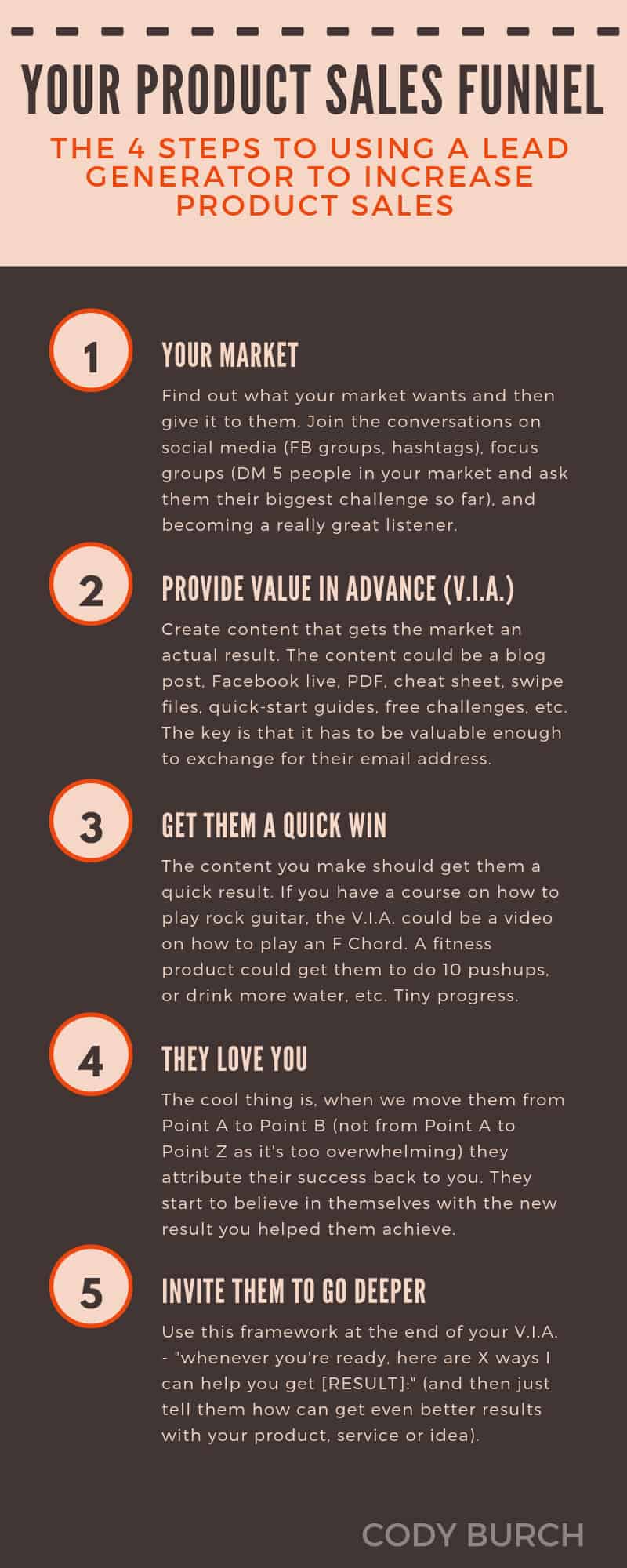
(These are the basic elements of building a sales funnel that I cover in detail in my book One Hour Funnel. In the book, I also include 3 proven sales funnel templates you can use to get as many leads and customers as you want without having to hire an agency.)
A sales funnel is the step-by-step, hold-your-hand approach to converting strangers into customers.
Here’s a simple mockup so you can visualize what I mean:

How To Turn Strangers Into Customers With a Product Sales Funnel
You might be wondering “why does it matter if we grab their email address? What if we just gave them access to the value without asking them to sign up to our email list?”
I’m glad you asked…
You STILL should be collecting email addresses
There are a few reasons gathering email addresses is really important.
- You own the list. You don’t own your Facebook fans, your IG or YouTube subscribers. A simple change to the algorithm (or getting your account shutdown) can leave you out in the cold with no way to reach your audience. You also are at risk that something new will come and go (I’m looking at you, Vine). And if you build a big platform without “owning” the data such as an email address collected via a landing page, you’re at risk of losing it all.
- Custom audiences. If you use any kind of pay-to-play platform (FB or Google/YouTube ad platforms) you can upload your email list as a custom audience. And, if the platform changes – fret not! – you have the email list of your subscribers.
Case Study #2
On a recent launch with a similar product (roughly $1K offer) – check this out:
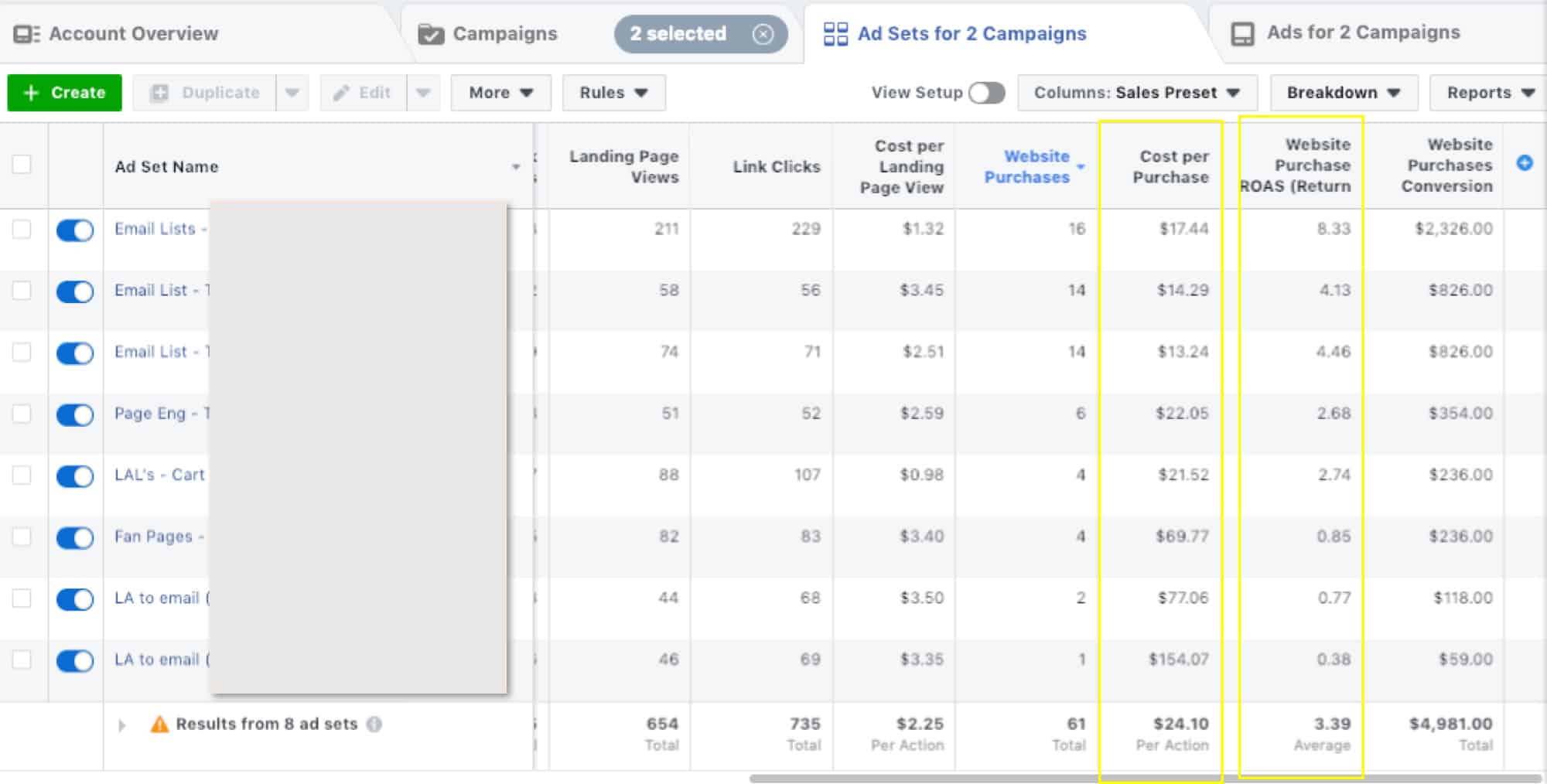
I know there’s a lot of data here so I’ll walk you through it. On the first column, you can see we were targeting people that were on an email list, had engaged with the page (viewers), lookalike audiences, and people who were actual fans of the page.
The columns highlighted in yellow rank the best-performing ad sets by ROAS (return on ad spend). As you can see, the top 3 of the 8
Oh, and by the way, for this campaign we launched a 5-day challenge that was delivered primarily via emails. Don’t overthink the mechanisms and never over complicate it. Just add value to their life, get them a result, and watch what happens.
As you can see, adding value in advance and collecting email addresses matter for a bunch of reasons.
Here are some examples of ads that I’ve seen online to really drive the point home:
Free video series:
Here are some examples of ads that I’ve seen online to really drive the point home:
Free video series:
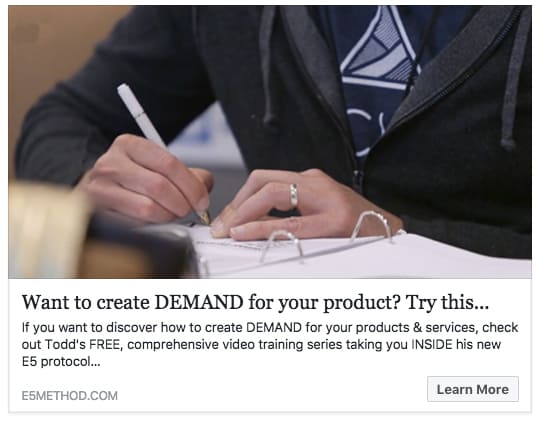
Free PDF (landing page cheat sheet)
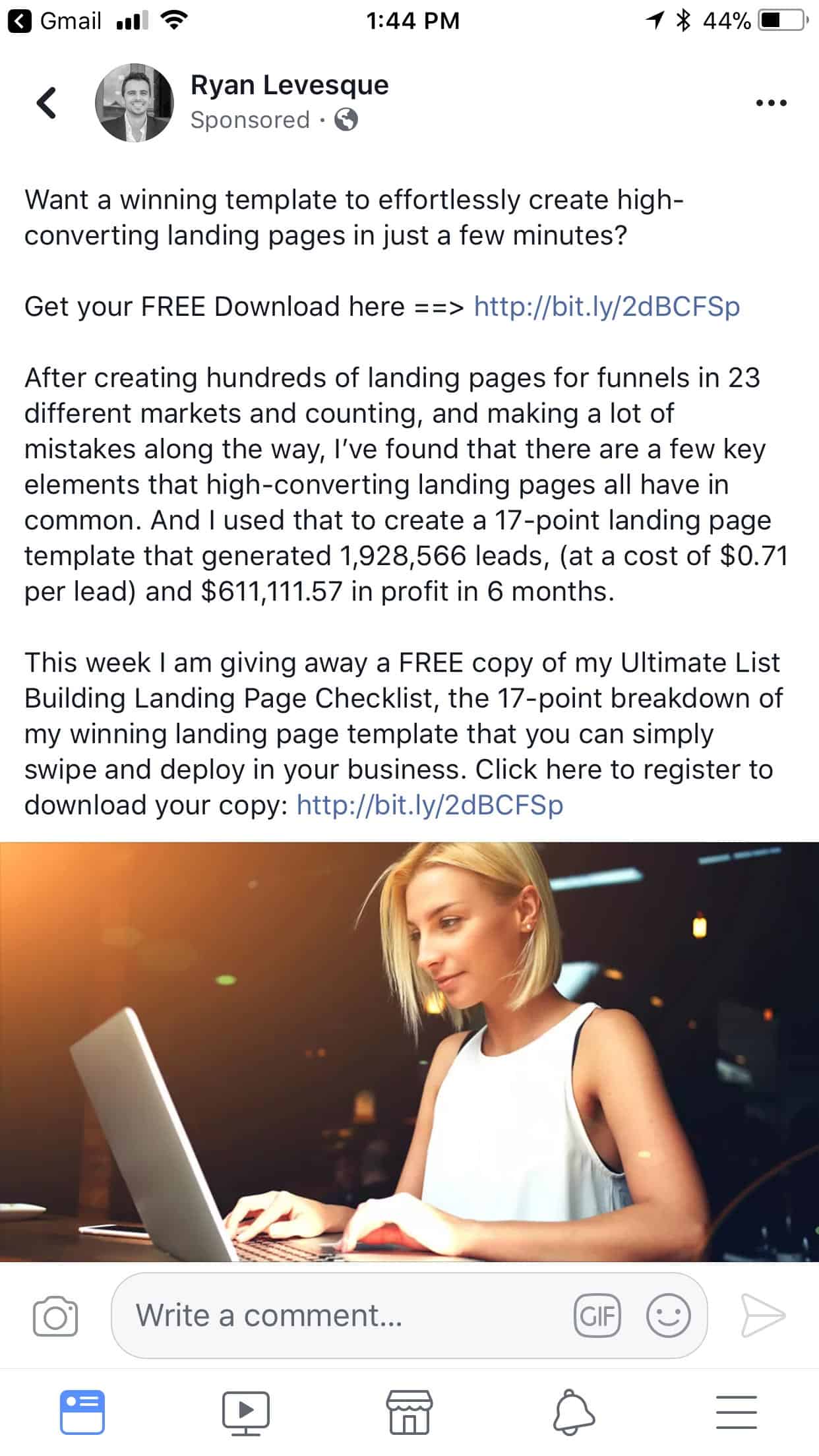
Free 90 Minute Video Training:

Free Download – The Irresistible Offer Template
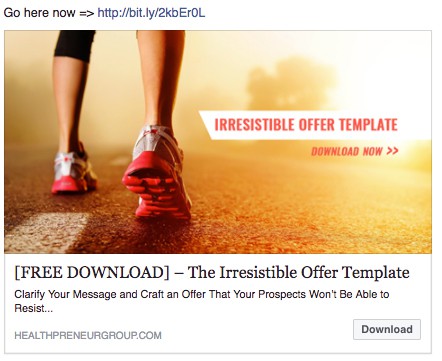
In summary –
Question: How do we increase the conversion rate on our sales pages?
Answer: By adding value in advance via a lead magnet you warm up your prospective customers and make them much more receptive to your offer.
Ready to make a lead magnet worthy of their email address?
If you’re not sure how to get started, take a sheet of paper and write down all the features and benefits of your core offer (your “magic trick”).
Quick tip – turn a feature into a benefit by saying “so you can”. If you sell a solar-powered watch the FEATURE is “solar powered” and the BENEFIT is “your battery will never die again.” If you sell a protein powder the FEATURE is “whole ingredients” and the BENEFIT is “less bloating” or “tastes better”. If you sell light bulbs the FEATURE is “60 watts” and the BENEFIT is “see in the dark.”
Create an exhaustive list of 10-20 features and benefits of your core thing. This is also covered in more detail on the podcast at codyburch.com/podcast (The episode is called: Bonus: Bagel Bites with Benefits after Episode 21. Direct link is here)
Here are some questions you can ask yourself when you’re creating your item of value (a.k.a. your lead magnet)
- What do they believe to be true about my product/industry, but isn’t? (ex: a “myth-buster” type of PDF, cheat sheet)
- What false beliefs do they hold about my product? (ex: “I’ve seen it all before” or “this is just like everything else”)
- What false beliefs do they believe about themselves when it comes to my product? (ex: this will never work for people like me” or “I can’t do it”)
- What are the alternatives to my product and why is mine the best? (ex: a buyers guide)
- What are the core elements of my product and what is the tiniest amount of result they can get? (Think of your product as a long row of dominoes that need to be knocked down in order to get a result. What is the first domino?)
- What questions do they have about your product? (ex: “Don’t step foot on a car dealership lot until you read this report!”)
- What social proof do you have that your product works? (ex: case studies and customer success stories)
And here’s the
29 Awesome Lead Magnet Ideas for Your Marketing Funnel
My favorite from the list is the dominoes example.
For example, if I want to teach someone how to build a great funnel I first need them to understand their market. So I could create a 1-page cheat sheet called, “Learn What Keeps Your Target Market Up At Night With These 3 Simple Questions”, for example.
People that engage with that content will be more likely to be interested in funnel building. The first domino has been knocked down, they’re getting great results already and attributing their success back to me.
Make sense?
It’s a much better approach than yelling at strangers from across the street.
How about you? Has lead generation and “value in advance” worked for you to increase your sales? How so?

